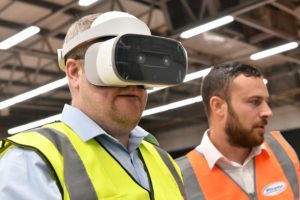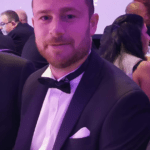John Kersey, SHP’s safety technology expert and judge in the SHP Trailblazer in Technology awards, speaks to Luke Robinson, H&S Programme, Strategy and Innovation Manager at Wincanton PLC, about his personal experiences in implementing and taking forward immersive training technology in the workplace.
 Wincanton is a British-based transport and logistics services provider specialising in automated high bay high capacity warehouses as well as container transportation and related services, such as health and safety, people transition and IT services to a range of industries. Luke joined Wincanton four years ago as a HSEQ training manager and his passion and enthusiasm for the subject was picked up by his director, who supported the growth of the team to 12 enthusiastic and pioneering individuals as well as investment in new technology for training.
Wincanton is a British-based transport and logistics services provider specialising in automated high bay high capacity warehouses as well as container transportation and related services, such as health and safety, people transition and IT services to a range of industries. Luke joined Wincanton four years ago as a HSEQ training manager and his passion and enthusiasm for the subject was picked up by his director, who supported the growth of the team to 12 enthusiastic and pioneering individuals as well as investment in new technology for training.
So far Wincanton has developed a RoSPA approved fire safety training course using virtual reality (VR) and a further approved course for accident investigation – both of these with a 100% success rate and an A rating for delivery. The individual pass scores have improved from 60% for the previous course to 90% for the VR enhanced course despite the assessment being now more challenging. For Wincanton, a positive commercial benefit was being chosen as the selected provider under the CLEAR (the Centre for Logistics Education and Research) scheme located on Magna Park, Europe’s biggest logistics park.
How did you first get involved in health and safety training?
 Luke Robinson (LR): “There were two separate things that influenced me. Firstly, I had back problems, so that was a personal motivation. Secondly, at the time I was working for Calor Gas with a selection of jobs I was then recommended by a colleague to look at safety as a career. At first, I was reluctant but as I slept on it and thought it over, I saw it was something that related to my other interests as a PE teacher and football coach. I then moved on to an educational establishment working with troubled adults and kids which gave me some really good safety experience and insights in working with and educating colleagues.”
Luke Robinson (LR): “There were two separate things that influenced me. Firstly, I had back problems, so that was a personal motivation. Secondly, at the time I was working for Calor Gas with a selection of jobs I was then recommended by a colleague to look at safety as a career. At first, I was reluctant but as I slept on it and thought it over, I saw it was something that related to my other interests as a PE teacher and football coach. I then moved on to an educational establishment working with troubled adults and kids which gave me some really good safety experience and insights in working with and educating colleagues.”
You were a finalist in the SHP Trailblazer in Technology Award. What do you see as the benefits of entering prestigious award, such as this?
(LR): “Engagement as a reader of the entries and a way of looking outside the tunnel vision and day-to-day operational issues. My company, Wincanton PLS was extremely pleased that we entered and it helps give a lot of weight to the training programme we are developing. It also supports our work in achieving a pioneering team’s goal.”
You are doing some impressive work using new technology for training at Wincanton – how is that being received by the trainees and line management?
(LR): “Even before they attend the session, we are noticing far greater attendance as the word of mouth has preceded the course. We are seeing far greater attendance than there was with previous courses. It has also dramatically increased engagement from trainees whilst they in the classroom. For ‘hands-on’ colleagues who may have a kinaesthetically learning preference this makes for a level playing field for training. Other types of training with documents and written tests probably give an unfair advantage to people who are more office based or academically minded. We are also using what they have learnt quickly in the workplace and at home.
“Here is a direct quote from one of our feedback sheets – ‘I have learnt how to inspect and correct any failings with the fire safety in my place of work and home.’”
Wincanton has invested in both new training methods and your team. Any tips for people on how to sell this to top management and the business in general?
(LR): “I had a long think and didn’t want to present to the directors something that was done before. That meant presenting through an industry standard wireless headset using six degrees of freedom (DoF) [edit this is a method of moving within and interacting with the virtual environment, three rotational degrees and three translational]. This gives a smoother user experience. Creating a differentiator was something that was important to the directors as well as proving that it works financially. For immersive technology like VR get colleagues to try it and demo the package. When presenting to senior executives you have to be accurate and precise and be prepared to get your point over in 10 minutes. I also focussed on Wincanton’s values and the commercial benefits of the proposal.”
How are you finding running VR courses for training especially fire training?
(LR): “Really, really rewarding and then amazing when colleagues put the headset on. Colleagues are getting much better results in their tests and they get that ‘ahh’ moment when they experience the VR. Colleagues also appreciate that we are not doing it to cut time but are providing a great experience for them. We are also seeing real behaviour change in the trainees after the course with safer and faster decisions. During the course I’m noticing the younger generation encouraging the older generation to interact with the technology and get a more positive experience with technology. We also use 360 imagery and are using this captured through a 360 camera to develop risk assessment and accident investigation packages that provide a good depth perception. We say a picture paints a thousand words, with VR it’s more like a million words.”
Do you have any practical challenges, such as people with health conditions or an aversion to using this type of technology? How do you deal with these?
(LR): “We start by showing on a screen what the person in the headset sees (casting) using a device like a dongle. When the trainees feel confident then they can try the headset themselves. Not every site has Wi-Fi or a good enough signal, so we have invested in a mobile router solution to get a strong signal for remote sites. The size of the class is from 12 to 16 people and we provide one or two headsets – each trainee will get an hour for revision time during the course. We use the VR package as an assessment tool rather than as a final assessment tool; as a mock test. For those that are nervous or anxious we give them a go using just a raw 360 image so they get used to the VR environment. We have had a colleague with only one eye and that need to use glasses and they haven’t proved to be an issue in using the headsets we provide.”
Have you seen any noticeable changes in fire risk management resulting from the VR training?
(LR): “Colleagues are even more proactive and proud to let the training team know how they are applying the training. We estimate 75% will positively change their behaviours post course. Perception of fire risk is the biggest problem in fire training, and it is a real gamechanger if people see that that as a real risk. We are noticing people checking fire doors, checking fire extinguishers and running fire drills.”
Developments in safety tech are moving fast – how do you keep in touch with emerging and future technology?
(LR): “We have got an innovation initiative called W² (W squared) that brings in new start-ups and technology providers so we can look beyond the daily grind. We also make time to look forwards and search out innovation – it won’t just come to you. At the same time, we are very focused on our risk profile so when we actively search for technology it fits the sectors we work within. I always look for something unique and, if possible, find the world’s first – that is exciting. I find having a good network of people brings on the conversations that helps here. Engage with tons of safety people and use word of mouth to find out what is out there. Smash Google and do searches for the most recent information on a topic or not more than six months. Have a two-way conversation with customers on what is new.”
What do you see as the future trends in this area?
(LR): “I love the thought of augmented reality when it is fully realised. As an example, I saw a map of a zoo online, it was more than a standard map. As you looked at the map it came to life with people and vehicles travelling around. Then the thought came to me we could use this for course workbooks by using tablets and go paperless. Make it easier for people. Create a level playing field.”
Logistics news app
SHD Logistics, provider of news, case studies and opinions from the logistics sector, has launched a new app. It will be available on the Apple App Store and on your desktop. Once downloaded, the app will allow you to save, read, search and share digital editions of SHD Logistics.
SHD covers many verticals including retail and fashion, food and beverage, engineering, manufacturing, and transport and distribution. SHD is a must-read publication for today’s busy logistics and supply chain professionals.
The Safety Conversation Podcast: Listen now!
The Safety Conversation with SHP (previously the Safety and Health Podcast) aims to bring you the latest news, insights and legislation updates in the form of interviews, discussions and panel debates from leading figures within the profession.
Find us on Apple Podcasts, Spotify and Google Podcasts, subscribe and join the conversation today!



